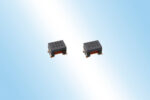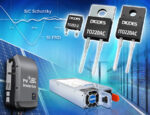TDK Corporation has announced the introduction of its new ACT1210E Series (3.2 x 2.5 x 2.5 mm (L x W x H)) of common mode filter for automotive Ethernet 10BASE-T1S. Mass production of this new common-mode filter began in February 2023. This product is the industry’s first common mode filter for automotive Ethernet 10BASE-T1S. Adopting […]
Tools
Copolymer resin meets stricter regulatory requirements for 1.5Kv solar systems
SABIC launched a breakthrough polycarbonate (PC)-based copolymer resin, well-suited for photovoltaic (PV) connector bodies, that meets stricter performance and regulatory requirements for emerging 1.5Kv solar systems. The new LNP EXL9334P copolymer resin achieves the highest comparative tracking index (CTI) level (UL PLC0) and IEC as Material Group 1 (IEC MG 1). It also delivers low-temperature […]
Eight SiC Schottky barrier diodes rated at 1200V
Diodes Incorporated announced the release of its first Silicon Carbide (SiC) Schottky barrier diodes (SBD). The portfolio includes the DIODES DSCxxA065 series with eleven products rated at 650V (4A, 6A, 8A, and 10A) and the DIODES DSCxx120 series with eight products rated at 1200V (2A, 5A, and 10A). These wide-bandgap SBDs bring the benefits of significantly […]
Electrostatic shielding now available for high-voltage reed relays
Pickering Electronics now offers optional electrostatic shielding for its 10kV stand-off Series 67/68 SIL/SIP reed relay families. Electrostatic screening protects against noise that can otherwise occur between the coil drive and high-voltage circuits. This new screening is in addition to Pickering’s internal mu-metal screen which eliminates magnetic interaction when devices are closely stacked. Series […]
Potentiometer models feature resistance ratings from 1 to 2000 kΩ
CUI Devices’ Motion and Control Group announced the addition of a new line of potentiometers. Available in shaft or shaftless options, these rotary potentiometers feature resistance ratings from 1 to 2000 kΩ and panel mount or through-hole mounting styles. With a rotational life of 10,000 cycles, CUI Devices’ PT and PTN family of potentiometers are ideal for […]
MEMS microphone trio address ear and wearables market
Knowles Corporation introduces its latest series of SiSonic MEMS microphones: Titan (Digital), Falcon (Differential Analog), and Robin (Single Ended Analog). The new trio of microphones provides advanced performance capabilities for space-constrained Ear and wearable applications like True Wireless Stereo (TWS) earbuds, smart watches, Augmented Reality (AR) glasses, and Virtual Reality (VR) headsets. Each of the […]
Precision thin-film resistors offer ±0.01% tolerances, ±2ppm TCRs
With the proliferation of electronics in nearly every market sector, there is an increasing need for precision resistors. For markets such as medical instrumentation and control, industrial and automotive controls, communications, and test & measurement, these precision resistors must maintain electrical and environmental stability long term. Stackpole’s RNCF series of precision thin film resistors meet these […]
IP67-rate, tactile switch in tiny 3 x 2 x 06 mm package
CUI Devices’ Switches Group announced the introduction of one of the industry’s smallest tactile switches. Housed in an ultra-compact 3 x 2 x 0.6 mm package, the TS19 series carries an IP67 rating for dealing with moisture and environmental contaminants as well as a rugged lifecycle rating of up to 300,000 cycles. These tactile switch models feature surface […]
6MHz rail-to-rail op amps boost performance in industrial and automotive apps
STMicroelectronics is simplifying designers’ search for high-performing operational amplifiers (op amps) by introducing three new 6MHz rail-to-rail devices with strong all-around parameters including a wide operating voltage range and low noise. The TSB511, TSB512, and TSB514 are single, dual, and quad op amps, respectively. They can operate from a single supply in the range from 2.7V to […]
Specialty compound addresses stringed demands of BiTS used to stress test
SABIC introduced the LNP KONDUIT 8TF36E compound, a new specialty material that helps address the stringent demands of burn-in test sockets (BiTS) used to stress-test double-data-rate (DDR) memory integrated circuits (ICs). As the number of pins and the testing temperature for DDR ICs increase and their dimensions shrinks, materials used in BiTS components must deliver […]










